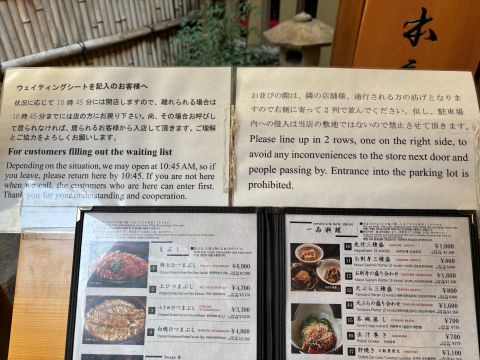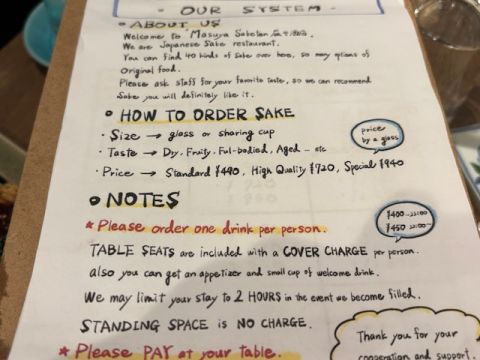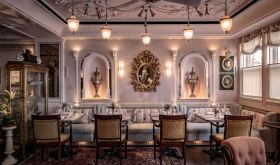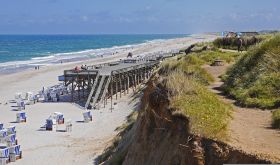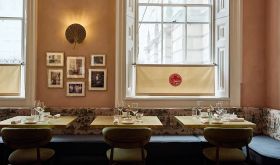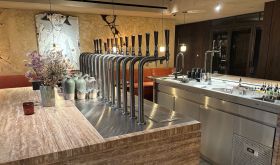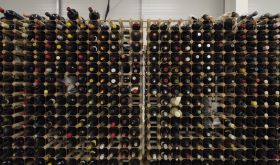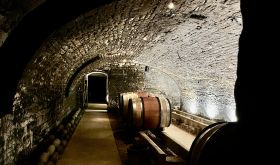Note: In order to deliver this article to you as early as possible, it has been translated with the use of AI. It has been added to a queue for a human translator to fully review and edit. Please pardon any minor translation imperfections while it is being reviewed.
任何顾客抵达任何餐厅时的主导情绪都会极大地影响他们接下来几个小时的用餐体验。
我永远不会忘记30年前的一篇餐厅评论,其标题是WIC——车内对话——指的是情侣在开车前往餐厅途中经常发生的激烈讨论。他们彼此说了什么,是否争吵,以及最终他们以什么样的心情抵达接待台,都会并且可能影响他们对餐厅的感知和享受。
我是否能以更放松或更愉快的心境抵达日本京都的本家谭熊本店 (Honke Tankuma Honten) 餐厅,我表示怀疑。在此之前的90分钟里,我们刚刚在龙足院 (Ryosoku-in) 佛教寺庙度过,在那里我享受了由佛教僧侣奉茶的古老仪式,随后品尝了一杯宝禄爵 (Pol Roger) 2015年香槟,然后在餐厅入口处参与了一个脱鞋仪式,涉及大约40双鞋子(及其主人),这些鞋子都被仔细编号。
由于我们人数众多,我们的团队随后被分配到不同的包间。我们被带到一个房间,每个座位前摆放着众多酒杯,这一点很引人注目。当我们拉开窗帘和推拉玻璃门后,眼前的景色变得越来越美。
从阳台上——我被告知再过几周餐厅就可以在那里摆放桌椅接待客人——我们能够观察到京都社会的一大部分人群,他们沿着鸭川 (River Kamogawa) 河岸步行、骑自行车和滑旱冰。在一年中的这个时候,河里没有蝾螈,据说这些蝾螈长达一米半,会从山上游下来。樱花沿着河的对岸盛开,后面建筑物相对较低的高度让我们能够清楚地看到环绕这座历史名城的群山。
在欣赏完这一切后,我们的注意力回到了餐桌和菜单上。这次聚餐是在PFV(Primum Familiae Vini,由12家顶级欧洲家族酒庄组成的集团)颁奖给堤浅吉漆商店 (Tsutsumi Asakichi Unisho-ten)——一家位于京都的家族企业,专门从事漆器的应用和精制——之后的午餐。因此,我们前五个酒杯很快就被装满了宝禄爵 (Pol Roger) 丘吉尔特酿 (Cuvée Winston Churchill) 2015年、侯伯王酒庄白酒 (Château Haut-Brion Blanc) 1996年、拉吉什侯爵 (Marquis de Laguiche) 2018年蒙哈榭 (Montrachet)、博卡斯特酒庄 (Château de Beaucastel) 老藤胡珊 (Vieilles Vignes Roussanne) 2020年教皇新堡 (Châteauneuf-du-Pape) 和安东尼世家 (Antinori) 塞瓦罗德拉萨拉 (Cervaro della Sala) 2018年的各种魅力。这是一个不错的开场阵容。
午餐组织者选择本家谭熊本店 (Honke Tankuma Honten) 作为这次午餐地点的决定很快就被证明是完全正确的。这家成立于1928年的餐厅的所有权跨越了四代人,我们的用餐前,现任主厨的母亲出现了。她微笑着、鞠躬着,身着优雅的和服,热情地欢迎我们。
自2009年以来,一直是她的儿子栗栖淳一 (Junichi Kurisu) 担任主厨,负责餐厅的第二颗米其林星,他面临着制作能够搭配世界顶级12款葡萄酒菜单的挑战。虽然他没有具体品尝过所有的葡萄酒,但据说他对精品葡萄酒极其了解。他的方法很典型的日式。他的餐厅的声誉显然建立在提供monmo料理的基础上,在京都方言中意思是"原汁原味",突出最时令菜肴的天然风味。这一理念让我立即伸手拿包,取出我那本有些破旧的理查德·霍斯金 (Richard Hosking) 不可或缺的《日本料理词典》(Japanese Dictionary of Food),该书出版于1995年,每次我访问日本时,它都是我行李箱中的第一件物品。
正是这本书解释了四月是吃竹笋的季节,这里与墨鱼和udo(春季山芦笋)一起供应,以及眼斑章鱼是头足类动物的一个特殊品种。
在随后的菜品中(总共有九道),这本书还解释了ainame是一种生活在岩石水域的日本白鱼,warabi是一种蕨菜。所有菜品都极其美味,摆盘精美,特别是与第一道菜一起供应的樱花树上小巧、色彩丰富的花蕾枝条。
时令食材的丰富继续体现在蚕豆配樱鲑鱼中,搭配我们的前两款红酒,贝加西西里亚 (Vega Sicilia) 尤尼科 (Único) 2004年(庄主巴勃罗·阿尔瓦雷斯 (Pablo Álvarez) 解释了大多数以4结尾年份的优越性)和托雷斯家族 (Familia Torres) 玫瑰园 (Mas de la Rosa) 2019年普里奥拉特 (Priorat)。接下来是两片烤和牛配manganji青椒(京都特产),搭配萨西卡亚 (Sassicaia) 2020年和木桐酒庄 (Château Mouton Rothschild) 2017年。然后我们回到白酒,品尝了雨果酒庄 (Hugel) 的雷司令舍尔哈默 (Riesling Schoelhammer) 2009年和伊贡·米勒 (Egon Müller) 的沙茨霍夫山卡比奈特 (Scharzhofberger Kabinett) 1994年,搭配sunomono菜品。这道简单的沙拉菜品因加入了taira-gai(扇贝)片而变得生动,浸在日式高汤中,顶部装饰着最精致的ho-shiso花。甜点是刚上市的草莓,放在用红藻制成的kanten果冻中,配红豆沙和一杯格拉汉姆 (Graham's) 50年陈年茶色波特酒。
用餐结束时,主厨进来接受了当之无愧的掌声。虽然日本餐厅有omakase(多道套餐)的传统,习惯于提供像我们这样的餐食,但主要由中年女性组成的服务团队的服务速度堪称典范。一队脚步敏捷的侍酒师提供的复杂酒类服务同样出色。
本家谭熊本店 (Honke Tankuma Honten) 价格昂贵。根据其网站,11道菜的套餐每人33,000日元(175英镑)。然而,京都并不缺乏价格便宜得多的用餐和饮酒场所。
我早就计划我们的第一餐要在金鳗 (Kaneyo) 用餐,这是一家有百年历史的餐厅,专门提供烤鳗鱼,这是日本和我个人最喜爱的菜肴之一。想象一下我的失望,当我发现我们的空闲午餐时间是周三,而这家餐厅恰好在这一天休息。与酒店接待员交谈后,提到鳗鱼,我们很快就前往京鳗和 (Kyo Unawa) 餐厅用餐。
这家餐厅是个宝石,从房地产角度来说一定价值连城。它位于一条小巷里,距离路易威登 (Louis Vuitton) 和大型大丸百货公司几百码。它有足够的停车位停放两辆车,在这个极其繁忙的地区是单层建筑——这个位置一定是开发商梦寐以求的。
但它继续作为一家极受欢迎的餐厅经营——事实上如此受欢迎,以至于入口处的标志(如下)指导等候的人们如何排队以及要有耐心。
在12:30之前,我们凭借酒店的预订走了进去,坐在柜台前,对面是一位年轻的女厨师,她在我们在那里的整个时间里都在切白菜,大概是要去腌制的。
菜单提供各种各样的菜品——他们的天妇罗特别好——但我真正感兴趣的只有一道菜,他们的鳗鱼,他们声称只使用每条重量超过300克的大型肥美鳗鱼。闪闪发光的漆盒送来了,五片鳗鱼在一堆米饭上闪闪发光,米饭很快就染上了鳗鱼的棕色。对于鳗鱼爱好者来说,这太棒了(甚至JR也成了转换者),我们很快就享用完了,然后我支付了9,370日元(50英镑)的账单。我离开时极其开心。
那顿午餐我喝了啤酒,但在PFV午餐盛宴的晚上,我提出了一个相对非凡的建议:假设任何地方的任何餐厅都不会有能与我们在午餐时有幸享用的葡萄酒相媲美的酒单,我认为我们应该尝试一家清酒酒吧。
我们走过京鳗和 (Kyo Unawa),很快发现自己坐在非常拥挤的升屋酒店 (Masuya Sakaten) 的一个角落里。
这家餐厅提供超过40种不同的清酒,将厨房、上方的中央吧台和约30个座位塞进一个非常小的空间里,当我们周四晚上7:30走进去时,里面挤满了人。它的清酒单让选择变得容易。
我们享用了两杯不同的清酒,一杯干型,另一杯被描述为果香型,然后分享了一大杯优质浓郁清酒。我们并不是特别饿,但配着这些我们点了一盘胡椒酱炖鸡,以及炸豆腐皮配牛肉味噌调料(如下)。整顿饭花费4,460日元(24英镑),让我们感觉像当地人一样。
本家谭熊本店 (Honke Tankuma Honten) 京都市下京区和泉屋町168号 600-8014;电话:+81 50 3628 1645
京鳗和 (Kyo Unawa) 京都市中京区八百屋町553-2号 604-8123;电话:+81 75 252 2233
升屋酒店 (Masuya Sakaten) 京都市中京区大日町426-1号 604-8044;电话:+81 75 256 0221
每个周日,尼克 (Nick) 都会写关于餐厅的文章。要了解他的最新评论,请订阅我们的 每周通讯。











